Adama Czartoryskiego street, Bydgoszcz
Adama Czartoryskiego street or Czartoryskiego street is a path located in the Old Town District (Polish: Stare Miasto) of Bydgoszcz, Poland. It portrays the industrial development that the city witnessed in the middle of the 19th century.
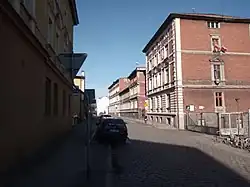 Street view westward | |
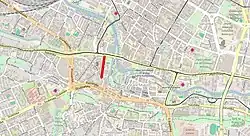 Czartoryskiego street highlighted on a map | |
| Native name | Ulica Adama Czartoryskiego w Bydgoszczy (Polish) |
|---|---|
| Former name(s) | Mautz Straße, Holz Straße |
| Part of | Old Town district |
| Namesake | Adam Jerzy Czartoryski |
| Owner | City of Bydgoszcz |
| Length | 300 m (980 ft) |
| Width | c. 10 metres (33 ft) |
| Location | Bydgoszcz, |
| Coordinates | 53°07′26″N 17°59′34″E |
| Construction | |
| Construction start | Late 1800s[1] |
Location
Located in the old town, the street follows a south-to-north path: stemming from Swiętej Trojcy street, it reaches its northern tip at Focha street.
History
A 1800 Map of Bromberg highlights a road parallel to the Brda river in the area,[1] with less than a dozen plots built.
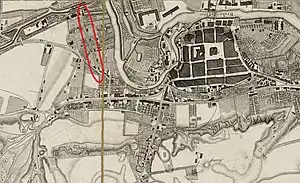
The first address books of Bromberg, dated 1855, identifies the path as Holz Straße[2] with 10 registered edifices, out of which three were the property of Henrich and Wilhelm Mauß.[2]
Naming
During its existence, the street bore the following names:[3]
- 1800s - early 1850s, not named;
- 1855 – 1875, Holzstraße,[2] literally the Wooden road;
- 1876 – 1920, Mautz Straße in reference to the Mauß (also spelled Mautz) family who owned several houses in the street, as early as the 1850s;
- 1920 – 1939, Ulica Ks. Adama Czartoryskiego;
- 1939 – 1945, Mautz Straße;
- Since 1945, Ulica Ks. Adama Czartoryskiego (English: Prince Adam Czartoryski street).
The current name refers to "Adam Jerzy Czartoryski (1770-1861), a Polish nobleman, statesman, diplomat and author. He was also a dedicated patron of arts and as such greatly contributed to the Czartoryski Collection. In 1798, he purchased one of Poland's most important national treasures – Leonardo da Vinci's Lady with an Ermine.
Main areas and edifices
Tenement at 12 Swiętej Trojcy Street, corner with Czartoryskiego street
1890s[4]
This tenement at then Berliner straße 30, was the property of Wilhelm Baesler a smith master,[5] who moved to Bromberg in the mid-1860s. The following landlord was also a smith, Julius Schmiede; his son Erich, a smith master, moved out in the mid-1920s,[6] but lived in Bydgoszcz until the start of World War II.
Both elevations on the street have arc pedimented windows, and the facade on Świętej Trojcy also displays pilasters on its ends. A wrought iron gate parts the building, giving access to a backyard on Czartoryskiego street.
 Corner house from the street
Corner house from the street.jpg.webp) Wrought iron gate, with Franke's spirit refinery building in the background
Wrought iron gate, with Franke's spirit refinery building in the background
Ancient iron foundry of Friedrich Eberhardt, at 2
The building housed one of the oldest city plants, Friedrich Eberhard's machine factory and iron foundry, opened in 1846.[7]
The company, known as Maschinenfabrik F. Eberhardt, installed in 1857, 3 horsepower (2.2 kW) steam engines in nearby Franke's distillery. A few years later, Eberhardt manufactured there more powerful steam engines, from 20 horsepower (15 kW) to 25 horsepower (19 kW) for local brick workshops.[8]
The edifice has been put for sell in 2018.[9]
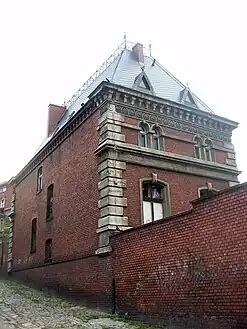 View from the Brda river
View from the Brda river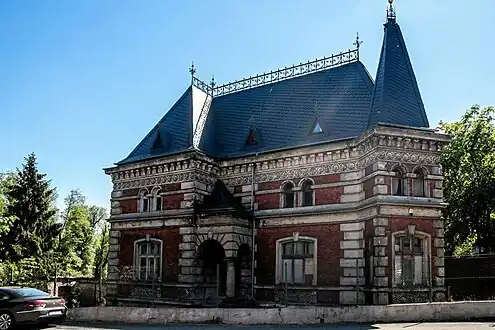 View from the backyard
View from the backyard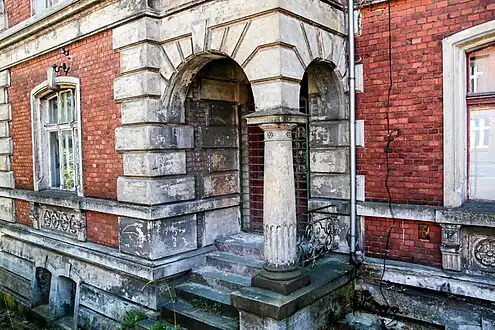 Entrance details
Entrance details
C.A. Franke's ancient spirit refinery, at 4/10
1880s-1890s[10]
Carl August Franke, the founder of the company, came to Bydgoszcz in 1827 from Leszno. At his death (1853), his son Hermann took over the management of the small family spirit distillery, making it a thriving factory.
After a first expansion of the workshops at Podwale street in 1872, the daily of spirit output reached about 3,500 liters. In order to solve the storage issue, Hermann purchased in 1887, a large plot of land at then "Mautz Straße", along the lateral stream bed of the Brda river.[11] The spirit warehouse erected there was equipped with cement cisterns and iron tanks, capable of holding about 1 million liters of spirit (increased shortly to 1.75 million liters).
In 1893, a large and modern refinery factory was added beside the warehouse: together, both plants (the newly built one and the old one on Podwale street) enabled a daily production of 10,000 liters of spirit.
At that time, the firm employed almost 30 people and its working capital attained about 750 000 German gold marks. The plant operated through the interwar period and the German occupation period, but under German ownership.[12] After World War II, the factory has been nationalized and gradually ceased its activity.
Public baths were set up by C.A. Franke:
- in 1874, on the Brda river, at the corner of today's Podwale and Grodzka streets;
- in 1894, on the lateral branch river, along Czartoryskiego street.
These facilities, located close to the refineries, used the hot water from the industrial liqueur process. During many years, these bathing houses were the only ones available downtown to meet the needs of the Bromberg residents.[13] With the development of the urban water network, facilities gradually lost their importance after WWI. The bath house at Czartoryskiego housed twelve cabins with bathtubs (1st class) and showers - separate for men and women. The equipment was dismantled in 1935, when the Franke family immigrated to Germany, selling the property back to Polish buyers.[14]
One can notice, a neo mannerist old office building[15] at 6. In the adjoined courtyard there is a bas-relief called Children in a bath, recalling the period when baths used to stand here.[16]
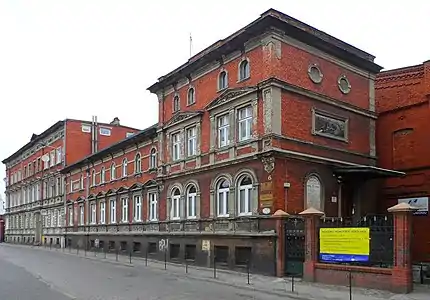 View of the buildings at 6/8/10
View of the buildings at 6/8/10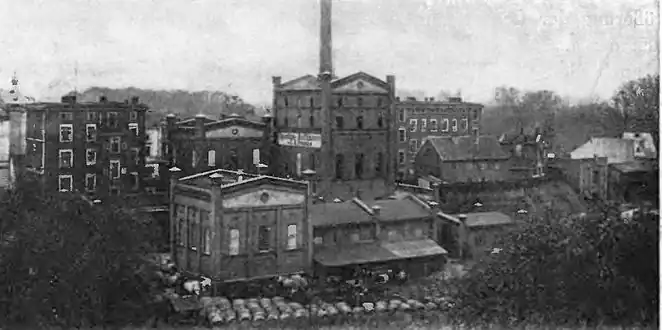 The refinery ca 1907
The refinery ca 1907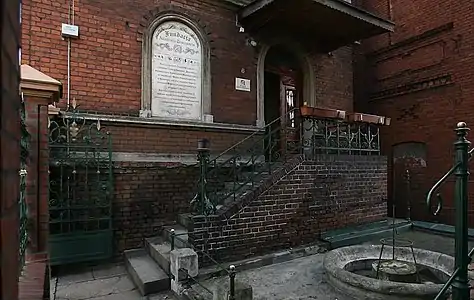 Entrance of the former baths at 6
Entrance of the former baths at 6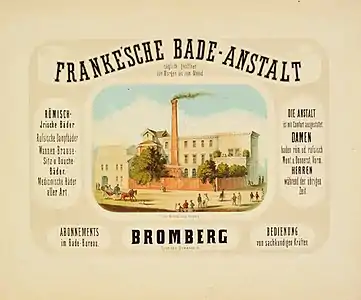 1928 advertising for the Franke bath house
1928 advertising for the Franke bath house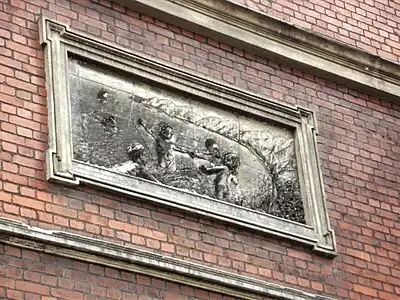 Bas-relief, "Children in a bath"
Bas-relief, "Children in a bath"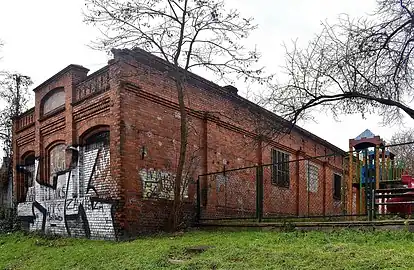 Back of the building at 8, view from the lateral river
Back of the building at 8, view from the lateral river
Factory at 7
The place used to harbour a workshop. Sold in 2019,[17] the new owner plans to build there an hotel.[18]
 View from the street
View from the street
Ernst Till Workshop, at 9
In the mid 1880s, Ernst Till, a smith master, opened there his workshop. At the time, the plot was registered on "Berliner straße" (present day's Swiętej Trojcy Street).[19] Ernst and his descendants owned the place until the 1930s.[20]
Today, the plot is still opened on both streets; the path to Swiętej Trojcy Street leads to the parvise of the Church of the Holy Trinity.
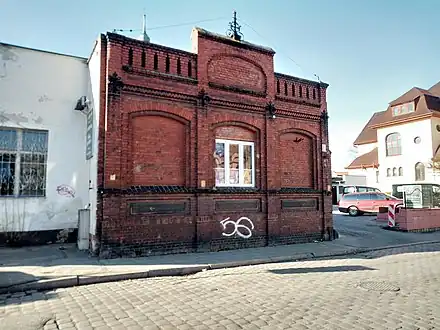 View from the street
View from the street
"Betezda" charity mission house, at 12
Early 1880s
The plot, then at "4 Mautz Strasse", was first owned by Heinrich Mautz in the 1850s, as located at "Holz Straße".[2] In 1890, it became the property of the C.A. Franke" company.[11]
Since 2004, it has been housing a mission of the Congregation of the Baptist Church in Bydgoszcz, the "Centrum Chrześcijańskie KANAAN - Misja BETEZDA" (English: KANAAN Christian Center - BETEZDA Mission).[21]
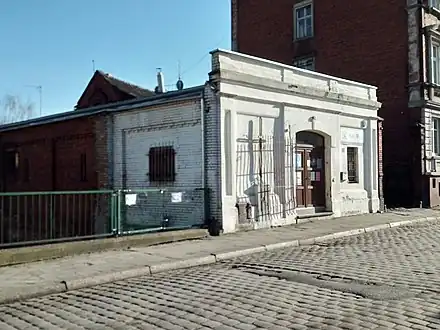 View from the street
View from the street
Franke Villa at 13
Beginning of the 20th century
The plot has been for a long time utilized as a garden. It's only in 1908 that Hermann Franke had this villa erected.[22]
The building has Art Nouveau features and is noticeable by its corner tower topped with a cupola. The entrance porch bears the initial "CF" , in reference to Carl Franke, father of Hermann Franke. The edifice, till the 1980s, used to be the "Civilian Registry Office", especially for weddings. Currently, it hosts various institutions, including the local alliance of Trade Unions.[23]
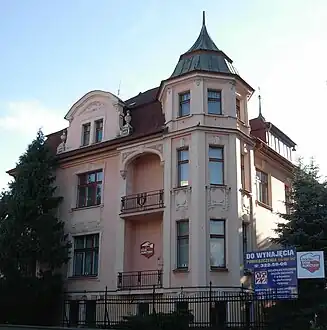 View from the street
View from the street Tower detail
Tower detail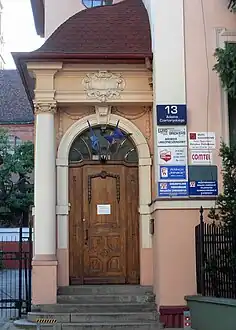 Main entrance
Main entrance
Buildings at 16
Second half of the 19th century.[2]
The plot presents a large early modernist building, giving onto the street.
The oldest edifice, however, is located at the back of the parcel and gives onto the river. It consists of a brick and wattle-and-daub house, supported by rocky foundations.
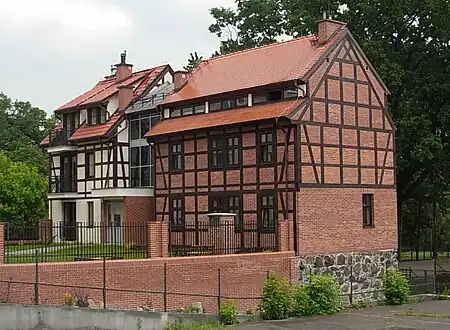 Wattle and daub house
Wattle and daub house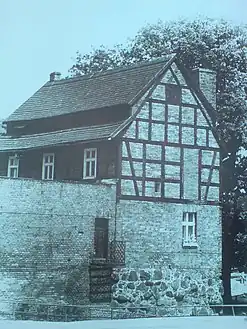 Early 20th century picture
Early 20th century picture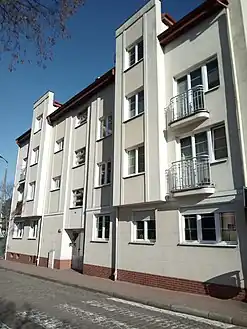 Main elevation on the street
Main elevation on the street
House at 20, corner with Focha street
1855-1857, by Heinrich Mautz
The house at then Maußstraße 1 has been built by master carpenter Heinrich Mautz for his own use,[25] as he owned a sawmill on the river.[26] Since 1887, the villa housed the military general commanding the Prussian 4th Division billeted in Bromberg.[11] After 1920, the place was owned by the State Treasury of Poland, housing there the general commanding the 15th Infantry Division:[27] in the 1930s, general Wiktor Thommée lived there.[24] During World War II, it was the HQ of the Nazi security forces: a plaque in memoriam has been placed. After World War II, it has housed a municipal branch of the city tax office (Polish: Izba Skarbowa).
The two-storey villa has got very neo-classical features, a set of identical windows one the ground floor and a series of smaller, square openings above. The entry gate on Czartoryskiego street has particularly well adorned lintel and pilasters.
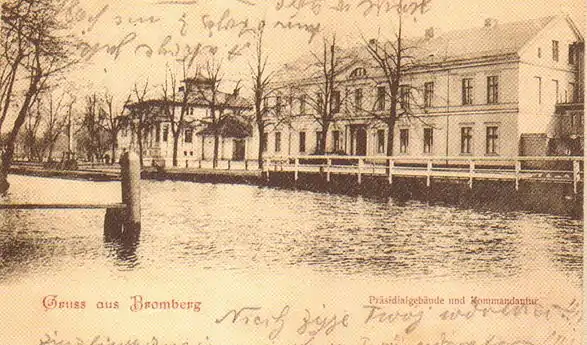 1900 view with the house on the left
1900 view with the house on the left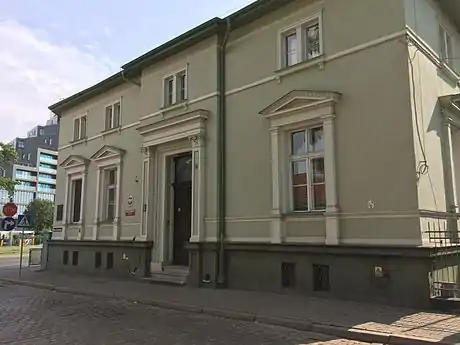 Facade on Czartoryskiego street
Facade on Czartoryskiego street Plaque on the house
Plaque on the house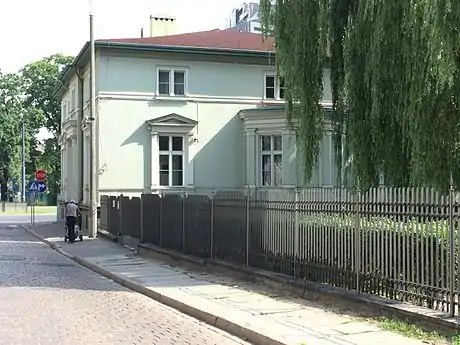 Partial view of the garden
Partial view of the garden
House at 25 Focha street, corner with Czartoryskiego street
1799[28]
The villa has been, from 1836 to 1920, the official residence of the presidents of the Bydgoszcz Regency (German: Regierungsbezirk,Polish: Rejencja), as the northern of two Prussian administrative regions of the Grand Duchy of Posen (1815–49) and the Province of Posen (1849-1918). The president executive office was located in today's Regional Office Building. The first president to occupy the site was Carl von Wissmann.[28] In front of the house ran the Old Bydgoszcz Canal till 1973: opposite the villa was located one of the lock (Polish: Śluza II "Grottgera") at the level of Artur Grottger street. During the evacuation of the city by Prussians in summer 1919, furniture and equipment of the palace was spirited away.
The vast edifice has only one storey. Its elevation on Focha street displays a perfect symmetry with two annexes with vehicle gate on both side. The main entry features typical neo-classical elements: the gate is flanked by two columns, topped by a large lintel. The ensemble is part of an avant-corps crowned by a temple-like triangular pediment.
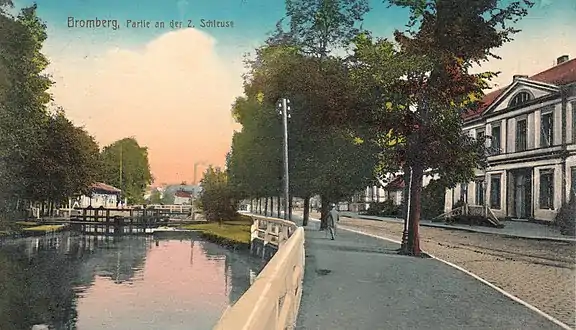 Villa at Nr.25 in 1914, in front of the Old canal lock
Villa at Nr.25 in 1914, in front of the Old canal lock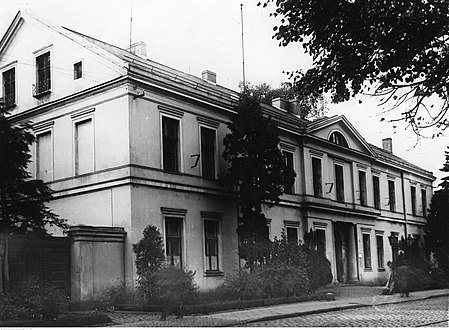 Picture of Regency building ca 1900s
Picture of Regency building ca 1900s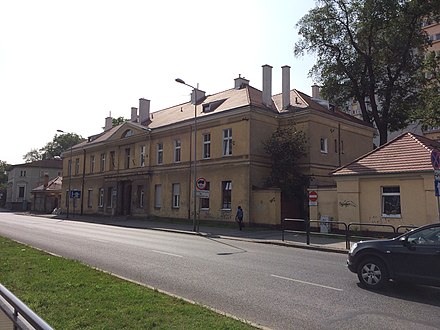 View from the street
View from the street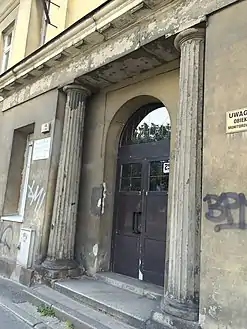 Main gate
Main gate
See also
References
- Lieutenant von Lindner (1800). Bromberg . - Specieller Plan der Königl. preuss.-an der Brahe-Flus liegenden Handlungs und Haupt-Stadt Bromberg in Netzdistricte [Bydgoszcz . - Special Plan of the Royal Prussia.-Action and capital city of Bromberg in Netzdistricte lying on the Brahe river] (Map) (in German). Bydgoszcz: L. Schmidt (Berlin). Retrieved 21 January 2023.
- "Streets". Allgemeiner Wohnungs-Anzeiger fur Bromberg 1855. Bromberg: Dittmann. 1855. p. 21,54.
- "Bromberg / Bydgoszczy (1925 - 1936/37 polnisch)". werder.net. MueGlo. December 2022. Retrieved 21 January 2023.
- Jasiakiewicz, Roman (24 April 2013). Uchwala NR XLI/875/13. Bydgoszcz: Miasta Bydgoszczy. p. 1324.
- "Straßen". Adressbuch nebst allgemeinem Geschäfts-Anzeiger von Bromberg und dessen Vororten auf das Jahr 1855 auf Grund amtlicher und privater Unterlagen. Bromberg: Louis Levit. 1864. pp. 3, 8.
- "Names". Książka Adresowa Miasta Bydgoszczy. Bydgoszcz: Władysław Weber. 1926. p. 312.
- Bromberk, Bartłomiej; Kosecki, Adam; Łaniecki, Sławomir (2021). BYDGOSZCZ PRZEMYSŁOWA DAWNIEJ I DZIŚ [Industrial Bydgoszcz before and today] (PDF) (in Polish). Bydgoszcz: Wydawnictwa Uczelniane Uniwersytetu Technologiczno-Przyrodniczego. ISBN 9788366530379.
- Böhm; Schmidt, Erich (1907). Industrie und Gewerbe in Bromberg [Industry and Business in Bromberg] (in German). Bromberg: Dittmann.
- mc (8 May 2018). "Zabytkowy budynek na Wyspie czeka na gospodarza". bydgoszcz.wyborcza.pl. Agora SA. Retrieved 21 January 2023.
- Gminna Ewidencja Zabytków Miasta Bydgosky [Communal Register of Monuments of the City of Bydgoszcz] (in Polish). Bydgoszcz: Miasto Bydgoszczy. 2015. p. 10.
- "Streets". Adressbuch nebst allgemeinem Geschäfts-Anzeiger von Bromberg und dessen Vororten auf das Jahr 1890 : auf Grund amtlicher und privater Unterlagen. Bromberg: Dittmann. 1890. p. 42.
- Biskup, Marian (1999). Historia Bydgoszczy. Tom II cz. 1 1920-1939. Bydgoszcz: Bydgoskie Towarzystwo Naukowe. p. 136. ISBN 83-901329-0-7.
- "Dawny przemysł w Bydgoszczy - Rafineria spirytusu". bydgoszcz.naszemiasto.pl. bydgoszcz.naszemiasto. 10 January 2015. Retrieved 10 January 2019.
- "Gdzie stał bydgoski Manneken Pis?". bydgoszcz.wyborcza.pl. bydgoszcz.wyborcza. 6 February 2013. Retrieved 10 January 2019.
- Bydgoszcz Guide. Bydgoszcz: City of Bydgoszcz. July 2014. p. 118. ISBN 978-83-917786-7-8.
- "Dawna Łaźnia Publiczna". visitbydgoszcz.pl. Bydgoskie Centrum Informacji. 2016. Retrieved 10 January 2019.
- "Ten odrapany i pobazgrany sprayem mur przy Czartoryskiego 7 powinien zniknąć". bydgoszcz24.pl. Bydgoszcz24. 23 April 2019. Retrieved 22 January 2023.
- "MAPA INWESTYCJI". bydgoszczwbudowie.pl. Bydgoszcz w Budowie. 2022. Retrieved 22 January 2023.
- "Streets". Wohnungs-Anzeiger nebst Adress- und Geschäfts-Handbuch für Bromberg und Umgebung : auf das Jahr 1885. Bromberg: Dittmann. 1885. p. VI.
- "Names". Książka Adresowa Miasta Bydgoszczy : na rok 1933. Bydgoszcz: Władysław Weber. 1933. p. 316.
- "Nasza historia". misjabetezda.pl. Centrum Chrześcijańskie Kanaan Kościół Lokalny Misja Betezda w Bydgoszczy. 2023. Retrieved 22 January 2023.
- "Streets". Adressbuch nebst allgemeinem Geschäfts-Anzeiger von Bromberg mit Vororten für 1908 ; auf Grund amtlicher und privater Unterlagen ; bearb. von C. Gardiewski. Bromberg: Dittmann. 1908. p. 126.
- zbyszekf60 (2007). "Willa miejska z pocz. XX w." polskaniezwykla.pl. Polska Niezwyk. Retrieved 27 January 2023.
- "Industriegeschichte Brombergs". visitbydgoszcz.pl. Bydgoskie Centrum Informacji. 2016. Retrieved 5 April 2016.
- "Straßen". Adressbuch nebst allgemeinem Geschäfts-Anzeiger von Bromberg und dessen Vororten auf das Jahr 1880 [Address book of Bromberg area in the Year 1880]. Bromberg: Mittler. 1880. pp. 20, 48, 80.
- Bydgoszcz Guide. Bydgoszcz: City of Bydgoszcz. July 2014. p. 118. ISBN 978-83-917786-7-8.
- "Instytucje i Urzędy Państwowe". Książka Adresowa Miasta Bydgoszczy 1928. Bydgoszcz. 1928. p. XI.
{{cite book}}: CS1 maint: location missing publisher (link) - "Kanał Bydgoski". TeH2O. ludzieitechnika. 2016. Retrieved 5 April 2016.
Bibliography
- Umiński, Janusz (1996). Bydgoszcz. Przewodnik (in Polish). Bydgoszcz: Regionalny Oddział PTTK "Szlak Brdy".
